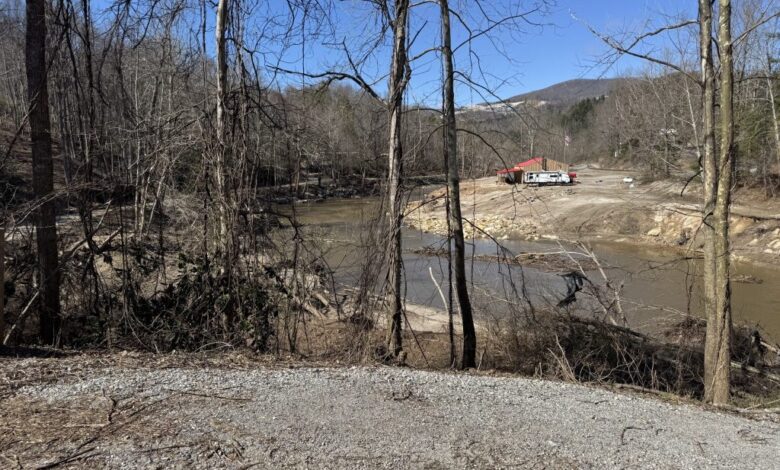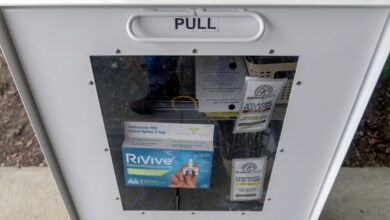Spruce Pine’s wastewater plant rebounds after Hurricane Helene’s destruction


By Will Atwater
The Town of Spruce Pine Wastewater Treatment Plant processes sewage from thousands of customers, including residents of the town and surrounding areas. Once cleaned, the water is returned to the North Toe River, which typically flows languidly westward. The placid scene on a recent visit was a far cry from the violence the river unleashed on the plant in late September when Hurricane Helene devastated western North Carolina, dropping more than 23 inches of rain on Mitchell County alone and causing the North Toe to breach its banks.
Nearby, heavy machinery was still — six months later — scooping up silt that blanketed the ground, a lingering sign of the river’s past aggression.
Even before Helene arrived, the region’s creeks and streams were saturated from several days of precipitation, according to a report by the National Oceanic and Atmospheric Administration.
“Depending on where you were in the region, Helene dumped anywhere from an additional 18 to 30 inches of rain in less than 24 hours,” said Daniel Stines, Spruce Pine’s town manager.
“To give you some perspective, a 100-by-100-foot impervious surface with one inch of rain will produce 1,000 gallons of water,” he said. “Think about the magnitude across all the rocky land we’ve got up here — all the buildings, the streets, all the stuff that water runs off. Then you can start to grasp how you get to trillions of gallons flowing into the rivers.”
With nowhere to go but up and out, the river flooded Spruce Pine’s wastewater treatment plant with water and silt.
“Nobody’s ever seen a storm of this magnitude here,” said Travis Phillips, Spruce Pine’s public works director. “Hurricanes come into beaches, and beach towns are designed for the water to come up and go back out. We had so much water here that there was nowhere for it to go — so the rivers filled up and spread open.”
The damage to the plant was so severe that, just days after the storm, North Carolina Sen. Ralph Hise (R-Spruce Pine) told NC Health News, “Mitchell County Water Treatment System for the entire county, both towns, is gone.”

To meet immediate needs, the town leased two mobile wastewater treatment units, known as BlueBoxes, from a Texas-based engineering firm. The six-week rental cost Spruce Pine $1.2 million, according to officials.
‘Everything at once’
Thanks to an all-hands effort and a stretch of dry weather in the fall, the plant — once seemingly on life support after being battered by the storm — is now treating approximately 700,000 gallons of wastewater per day, with a maximum daily capacity of 2 million gallons, Stines said.
Including the cost of the BlueBox rentals, Stines said the total cost of emergency repairs to the plant has exceeded $2 million.
So far, the North Carolina General Assembly has allocated more than $1 billion in Helene recovery funds, according to reports. Stines said those funds are made available to municipalities in the form of low-interest loans that are designed to support relief efforts until FEMA reimbursements come through.
Phillips stressed the need for FEMA support.
“The majority of this work will hopefully be FEMA reimbursable,” Phillips said. “This is a lot larger than what a small town like this can afford to do or sustain doing because of the magnitude of having to do everything at once.”
Completing the paperwork to qualify for FEMA funding, however, can be an overwhelming process, Stines said.
“It’s a very administratively taxing process to do things through FEMA,” Stines said. “The money is not frozen […] It’s just a matter of local governments getting their processes in place in order to get that money back.”
Aside from reimbursing for money spent to cover repairs to the plant, Stines said FEMA also will provide mitigation funds to help with “rebuilding or upgrading the sewer plant.”
Seeking higher ground
As part of its long-term mitigation strategy, the town is planning to build a new treatment plant on higher ground, thus reducing the risk of future flooding. Phillips said the move involves buying land uphill from the existing plant — a step that is already under discussion.
In addition to relocating the plant, Phillips said the town could consider switching from a conventional wastewater treatment system to a membrane system — a more flexible option that requires less infrastructure and a smaller footprint. However, he did not say whether the town is actively pursuing that option.
Given the extent of the damage caused by Helene, Stines said he’s pleased with the progress so far.
“It may not look like the prettiest facility on the ground because of the flood and the damage, but at the end of the day, the primary objective was to make sure the water was clean going back to the river, and we have been successful,” he said. “That’s been our biggest achievement.
“There’s still plenty of work to do, but we’re very pleased with the contractors we’ve had on site helping us get [the plant] back up and rolling. Our public works staff has been phenomenal.”
Last month, NC Health News asked Hise whether, beyond relocating the wastewater treatment plant, there were plans to strengthen the energy grid to prevent prolonged power outages during future storms.
“We’re in the rebuilding phase right now,” he replied. “The resiliency will come later.”
The post Spruce Pine’s wastewater plant rebounds after Hurricane Helene’s destruction appeared first on North Carolina Health News.




